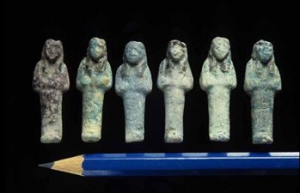General information on Ramose’s tomb
The Troop-commander and Deputy of the Army Ramose is mentioned in the adjacent tomb of Horemheb. He is there represented behind the chair of his superior and must have been an assistant of the general. Doubtless, he owed the privilege to be buried next to his master to this trusted position. Ramose appears to have died childless: his funerary rites were performed by his brother Tjay instead of by the expected eldest son. Otherwise, nothing is known of this army officer who must have lived during the end of the 18th Dynasty. His tomb was plundered in antiquity, then revisited by art robbers in the 19th century who sold the stela to the Berlin Museum. Ramose’s monument was rediscovered and fully excavated in 1986.

Superstructure of Ramose’s tomb
The tomb is situated on the north side of Horemheb’s, along its western end. The superstructure is 23 m long and 8.8 m wide. It consists of an outer courtyard, an inner courtyard, and three chapels (the central one with two columns, probably to carry the weight of a small pyramid on the roof). All walls are built in mudbrick; there are no pylons but instead the gateways have westward returns for the walls to appear thicker. The floors are of compacted mud, except for the central chapel which had proper limestone paving. Likewise, limestone revetment (now completely robbed away) was restricted to the central chapel and the walls flanking its entrance. This may be due to the unfinished state of the tomb. The Berlin stela originally stood against the west wall of the outer courtyard, where the remains of a companion piece are still extant. During the 19th Dynasty, Tia demolished Ramose’s outer courtyard to make way for the construction of his own pyramid.

Substructure of Ramose’s tomb
The substructure of the tomb consists of a 10 m deep shaft in the centre of the inner courtyard. This leads to a succession of four chambers at various levels, linked by means of an internal stairway and shaft. The total depth of this complex is 20.55 m. The rock walls of the main burial chamber have limestone revetment. Some fragments of shabtis and a canopic jar prove that Ramose was actually buried here. The tomb comprises a subsidiary shaft in the north-east corner of the inner courtyard, originally perhaps of Old Kingdom date like the main shaft. This was re-used as a Late Period burial complex and contained a plain limestone sarcophagus, dozens of uncoffined mummies, and hundreds of poor faience shabtis. A robber’s break-through in the north wall led to the discovery of the tomb of Maya, likewise in 1986.

Most interesting finds from Ramose’s tomb
Shabtis
Ramose had the titles of troop-commander and deputy of the army. As such, he was the assistant of general Horemheb and is depicted in the latter’s tomb. The location of Ramose’s tomb next to that of his master is a further proof of their close bond. It is rather remarkable, therefore, that on the shabtis from Ramose’s tomb there is only one title: that of ‘high priest’. This seems to reflect the well-known fact that anybody who had received a good education and was well versed in the hieroglyphic script (which is expressed by the title ‘royal scribe’) could expect to be appointed to highly varied posts in the civilian administration, in the army, or in the clergy. Unfortunately Ramose does not state which god he served; possibly he chose this career in a temple after his retirement from active service in the army.

Sarcophagus
A 10.7 m deep shaft opened in a corner of Ramose’s inner courtyard. This is not the original tomb-shaft of the tomb-owner, but a secondary shaft dating to the Late Period. The tomb-chamber had the characteristic shape of this period, with a rectangular central area flanked by a number of shallow loculi destined to hold a number of
mummies. In front of one of these mummy-niches stood a limestone sarcophagus of a type not previously found at the site. The sarcophagus box is hollowed out from a single block of stone, with a rounded head end and sides tapering to the feet. The interior shows a mummiform cavity with protruding head and rounded shoulders. The lid consists of a simple convex slab. Parallels are not unknown elsewhere in Saqqara and in Abydos. These are datable to the period around 300 BC in view of the mummies with cartonnages inside.

Ramose’s family relations

Objects from Ramose’s tomb in museum collections
Berlin, Ägyptisches Museum 7306: stela
Leiden, Rijksmuseum van Oudheden F 1987/3.17-18: vessel fragment and set of shabtis (excavated finds, acquired as part of partition)
Bibliography
Final report:
Martin, G.T. et al., The Tombs of Three Memphite Officials, Ramose, Kha’y and Pabes (London, 2001).

